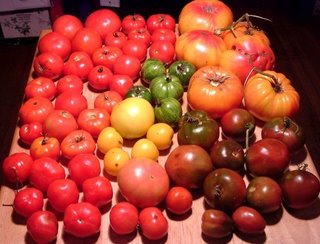 My roomie, Cyd, went outside to pick "a few" tomatoes to slice up for a salad last night, and this is what happened! Ah, the September Tomato! Is there anything sweeter? And isn't this a glorious rainbow of a crop? I like to grow heirloom varieties, especially those in unusual colors like the tangy, striped Green Zebra that you see in the middle of the picture, or some of the beautiful black varieties that you see to the lower right of the image. But my very favorite kinds are the enormous yellow, orange and red bi- or tri-colors (upper right-hand corner) that look like a sunset and have a wonderful balance of both sweet and acid flavors.
My roomie, Cyd, went outside to pick "a few" tomatoes to slice up for a salad last night, and this is what happened! Ah, the September Tomato! Is there anything sweeter? And isn't this a glorious rainbow of a crop? I like to grow heirloom varieties, especially those in unusual colors like the tangy, striped Green Zebra that you see in the middle of the picture, or some of the beautiful black varieties that you see to the lower right of the image. But my very favorite kinds are the enormous yellow, orange and red bi- or tri-colors (upper right-hand corner) that look like a sunset and have a wonderful balance of both sweet and acid flavors.As heirloom tomatoes are not always as heavy-bearing as modern hybrids, I tend to overcompensate by overplanting. But I really scaled back this time--from my personal best (worst?) of about 80 plants to just 48 this year! (Tee hee.) I also like to save my own seeds from year to year. And if you think this is difficult to do or takes specialized equipment, think again! And it's a great way to grow different kinds of tomatoes that you happen to taste and enjoy and want to have again in the future. For example, when I was at the Burlington (VT) farmers' market a few weeks ago, I spied a Red Zebra (as you might guess, it looks just like the Green Zebra above, except that it's red with gold stripes--gorgeous!). So we bought the last two they had, and then came right home and saved the seeds so that I can grow it next season.
All you do is gently squeeze out the jellied insides of the tomatoes into a small plastic container (old yogurt cups works great). Rinse them a few times to wash away the majority of all the stuff that is not just the seeds, then fill the cup with water and set aside for a few days. Yes, they will start to smell a little funky and there may be some mold that floats on the top of the water. But fermenting the seeds is a very important step, because it removes the natural growth-retardant substance that coats the outside of the seeds. After about five days, carefully pour off the old water, and rinse the seeds a few more times. I then take a styrofoam plate and write the name of the variety on the rim with a Sharpie marker, and then spread the drained seeds out onto the plate, trying to make an even layer. Then just set the plate aside--somewhere it can't be disturbed--and allow the seeds to dry completely (a few days to maybe even a week). Finally, I put the saved seeds in a little paper coin envelope that I've labelled, store them in a dark, dry, cool place, and they will be ready to plant next March! This technique also works with peppers and squash, but I should mention that you only want to use non-hybrid varieties of vegetables for seed-saving. Some hybrids will produce infertile seeds that will not even germinate, and those that do germinate will not look exactly like the parent plant, so you don't know what you'll get. Then again, sometimes it's fun to be surprised, as I found out with my summer squashes that were natural cross-breeds from last season. They look odd, but they taste great. Finally, once you get into seed-saving and end up with more seeds than you would ever want to plant, you might want to join a seed-saving organization and trade seeds with others. I like to use the Garden Web Seed Exchange Forum where you can post a profile that lists the seeds that you're looking for and those that you have to share. Then you can arrange a swap with another member. It's great! You get all kinds of interesting seeds for the price of a stamp!
Enjoy the end of the harvest, my friends. And save a little something for next season's garden that can never come too soon.
3 comments:
So what is a really good, old fashioned, tomato-tasting tomato? I keep wanting to grow them, but have no idea where to start...
Truly, most any heirloom variety that you choose to grow will have more flavor than modern hybrids, IMHO. But if I had to choose just one, hands down, I would recommend Brandywine. Great big, pinkish-red fruits (over a pound) that have that true, old-fashioned tomato flavor. Brandywines consistently top everyone's list for the best-tasting tomato. Give it a try next year...you won't be sorry!
...and those really good ones are exactly the kind you DON'T find n the grocery store, aren't they?
Post a Comment